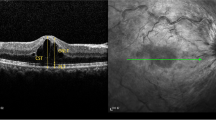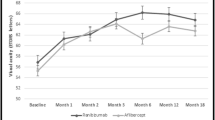Abstract
Purpose
To establish the morphological and functional parameters to predict the effectiveness of intravitreal injections (IVI) of ranibizumab in macular edema due to retinal vein occlusion and to develop a mathematical model for personalized treatment algorithms.
Material and methods
This is a retrospective study of 98 patients (98 eyes) with macular edema, who received IVI of ranibizumab and were followed up for 12 months. Spectral optical coherence tomography scans and best corrected visual acuity (BCVA) assessments were conducted every 3 months. Treatment outcome predictors were calculated based on logistic regression analysis.
Results
The most significant prognostic factors for the long-term BCVA were baseline BCVA (OR 11.1, p = 0.001), foveal volume (OR 10.8, p = 0.001), destruction of external limiting membrane (OR 15.8, p = 0.001), photoreceptor inner/outer segments (OR 11.1, p = 0.001) and retinal pigment epithelium (OR 9.1, p = 0.001). It has also been discovered that post-treatment BCVA correlated with the height of serous retinal detachment (SRD) (r = −0.4, p = 0.001), ganglion cell complex thickness (r = + 0.3, p = 0.01) and focal loss of ganglion cells (r =−0.3, p = 0.005). Patients without SRD required fewer ranibizumab injections (3.8 ± 1.1) for macular edema fluid resorption compared to those with SRD (5.7 ± 1.2, p = 0.03). A mathematical model for predicting and personalized approach therapy of ranibizumab has been obtained (accuracy of 89%).
Conclusion
The effectiveness of IVI of ranibizumab depends on baseline morphological and functional changes. The obtained mathematical model allows for predicting the outcomes of therapy, determining individualized algorithms to increase the treatment effectiveness and to prevent low vision that corresponds to the principles of predictive, preventive, and personalized medicine.



Similar content being viewed by others
Data availability
Data available on request due to privacy and ethical restrictions.
Code availability
Not applicable.
References
Berger AR, et al. Optimal treatment of retinal vein occlusion: Canadian Expert Consensus. Ophthalmologica. 2015;234(1):6–25. https://doi.org/10.1159/000381357.
Coscas G, Loewenstein A, Augustin A, Bandello F, Battaglia Parodi M, Lanzetta P, Monés J, de Smet M, Soubrane G, Staurenghi G. Management of retinal vein occlusion-consensus document. Ophthalmologica. 2011;226(1):4–28. https://doi.org/10.1159/000327391.
McIntosh RL, Rogers SL, Lim L, Cheung N, Wang JJ, Mitchell P, Kowalski JW, Nguyen HP, Wong TY. Natural history of central retinal vein occlusion: an evidence-based systematic review. Ophthalmology. 2010;117(6):1113-1123.e15. https://doi.org/10.1016/j.ophtha.2010.01.060.
Ponto KA, Scharrer I, Binder H, Korb C, Rosner AK, Ehlers TO, Rieser N, Grübel NC, Rossmann H, Wild PS, Feltgen N, Pfeiffer N, Mirshahi A. Hypertension and multiple cardiovascular risk factors increase the risk for retinal vein occlusions: results from the Gutenberg Retinal Vein Occlusion Study. J Hypertens. 2019;37(7):1372–83. https://doi.org/10.1097/HJH.0000000000002057.
Rehak J, Rehak M. Branch retinal vein occlusion: pathogenesis, visual prognosis, and treatment modalities. Curr Eye Res. 2008;33(2):111–31. https://doi.org/10.1080/02713680701851902.
Flammer J, Konieczka K. Retinal venous pressure: the role of endothelin. EPMA J. 2015;6:21. https://doi.org/10.1186/s13167-015-0043-1.
Daruich A, Matet A, Moulin A, Kowalczuk L, Nicolas M, Sellam A, Rothschild PR, Omri S, Gélizé E, Jonet L, Delaunay K, De Kozak Y, Berdugo M, Zhao M, Crisanti P, Behar-Cohen F. Mechanisms of macular edema: beyond the surface. Prog Retin Eye Res. 2018;63:20–68. https://doi.org/10.1016/j.preteyeres.2017.10.006.
Hayreh SS. Retinal vein occlusion. Indian J Ophthalmol. 1994;42(3):109–32.
Hayreh SS, Podhajsky PA, Zimmerman MB. Natural history of visual outcome in central retinal vein occlusion. Ophthalmology. 2011;118(1):119-133.e1-2. https://doi.org/10.1016/j.ophtha.2010.04.019.
Hayreh SS, Zimmerman MB. Branch retinal vein occlusion: natural history of visual outcome. JAMA Ophthalmol. 2014;132(1):13–22. https://doi.org/10.1001/jamaophthalmol.2013.5515.
Luna JD, Chan CC, Derevjanik NL, Mahlow J, Chiu C, Peng B, Tobe T, Campochiaro PA, Vinores SA. Blood-retinal barrier (BRB) breakdown in experimental autoimmune uveoretinitis: comparison with vascular endothelial growth factor, tumor necrosis factor alpha, and interleukin-1beta-mediated breakdown. J Neurosci Res. 1997;49(3):268–80. https://doi.org/10.1002/(sici)1097-4547(19970801)49:3%3c268:aid-jnr2%3e3.0.co;2-a.
Muraoka Y, Tsujikawa A, Murakami T, Ogino K, Kumagai K, Miyamoto K, Uji A, Yoshimura N. Morphologic and functional changes in retinal vessels associated with branch retinal vein occlusion. Ophthalmology. 2013;120(1):91–9. https://doi.org/10.1016/j.ophtha.2012.06.054.
Campochiaro PA, Bhisitkul RB, Shapiro H, Rubio RG. Vascular endothelial growth factor promotes progressive retinal nonperfusion in patients with retinal vein occlusion. Ophthalmology. 2013;120(4):795–802. https://doi.org/10.1016/j.ophtha.2012.09.032.
Pérez-Ruiz M, Ros J, Morales-Ruiz M, Navasa M, Colmenero J, Ruiz-del-Arbol L, Cejudo P, Clária J, Rivera F, Arroyo V, Rodés J, Jiménez W. Vascular endothelial growth factor production in peritoneal macrophages of cirrhotic patients: regulation by cytokines and bacterial lipopolysaccharide. Hepatology. 1999;29(4):1057–63. https://doi.org/10.1002/hep.510290416.
Kamei M, Terasaki H, Yoshimura N, Shiraga F, Ogura Y, Grotzfeld AS, Pilz S, Ishibashi T. Short-term efficacy and safety of ranibizumab for macular oedema secondary to retinal vein occlusion in Japanese patients. Acta Ophthalmol. 2017;95(1):e29–35. https://doi.org/10.1111/aos.13196.
Brown DM, Campochiaro PA, Singh RP, Li Z, Gray S, Saroj N, Rundle AC, Rubio RG, Murahashi WY, CRUISE Investigators. Ranibizumab for macular edema following central retinal vein occlusion: six-month primary end point results of a phase III study. Ophthalmology. 2010;117(6):1124-1133.e1. https://doi.org/10.1016/j.ophtha.2010.02.022.
Campochiaro PA, Heier JS, Feiner L, Gray S, Saroj N, Rundle AC, Murahashi WY, Rubio RG, BRAVO Investigators. Ranibizumab for macular edema following branch retinal vein occlusion: six month primary end point results of phase III study. Ophthalmology. 2010;117(6):1102-1112.e1. https://doi.org/10.1016/j.ophtha.2010.02.021.
Larsen M, Waldstein SM, Boscia F, Gerding H, Monés J, Tadayoni R, Priglinger S, Wenzel A, Barnes E, Pilz S, Stubbings W, Pearce I, CRYSTAL Study Group. Individualized ranibizumab regimen driven by stabilization criteria for central retinal vein occlusion: twelve-month results. Ophthalmology. 2016;123(5):1101–11. https://doi.org/10.1016/j.ophtha.2016.01.011.
Chatziralli I, Theodossiadis G, Chatzirallis A, Parikakis E, Mitropoulos P, Theodossiadis P. Ranibizumab for retinal vein occlusion: predictive factors and long-term outcomes in real-life data. Retina. 2018;38(3):559–68. https://doi.org/10.1097/IAE.0000000000001579.
Hirose M, Matsumiya W, Honda S, Nakamura M. Efficacy and visual prognostic factors of intravitreal bevacizumab as needed for macular edema secondary to central retinal vein occlusion. Clin Ophthalmol. 2014;8:2301–5. https://doi.org/10.2147/OPTH.S74888.
Jaissle GB, Szurman P, Feltgen N, et al. Predictive factors for functional improvement after intravitreal bevacizumab therapy for macular edema due to branch retinal vein occlusion. Graefes Arch Clin Exp Ophthalmol. 2011;249:183–92. https://doi.org/10.1007/s00417-010-1470-2.
Chung EJ, Hong YT, Lee SC, et al. Prognostic factors for visual outcome after intravitreal bevacizumab for macular edema due to branch retinal vein occlusion. Graefes Arch Clin Exp Ophthalmol. 2008;246:1241–7. https://doi.org/10.1007/s00417-008-0866-8.
Minami Y, Nagaoka T, Ishibazawa Akihiro, Yoshida Akitoshi. Correlation between short- and long-term effects of intravitreal ranibizumab therapy on macular edema after branch retinal vein occlusion: a prospective observational study. BMC Ophthalmol. 2017;17(1):90. https://doi.org/10.1186/s12886-017-0485-4.
Celık E, Doğan E, Turkoglu EB, Çakır B, Alagoz G. Serous retinal detachment in patients with macular edema secondary to branch retinal vein occlusion. Arq Bras Oftalmol. 2016;79(1):9–11. https://doi.org/10.5935/0004-2749.20160004.
Dogan E, Sever O, Köklü Çakır B, Celik E. Effect of intravitreal ranibizumab on serous retinal detachment in branch retinal vein occlusion. Clin Ophthalmol. 2018;17(12):1465–70. https://doi.org/10.2147/OPTH.S162019.
Fujihara-Mino A, Mitamura Y, Inomoto N, Sano H, Akaiwa K, Semba K. Optical coherence tomography parameters predictive of visual outcome after anti-VEGF therapy for retinal vein occlusion. Clin Ophthalmol. 2016;10:1305–13. https://doi.org/10.2147/OPTH.S110793.
Imai A, Toriyama Y, Iesato Y, Hirano T, Murata T. En-face swept-source optical coherence tomography detecting thinning of inner retinal layers as an indicator of capillary nonperfusion. Eur J Ophthalmol. 2015;25(2):153–8. https://doi.org/10.5301/ejo.5000514.
Groneberg T, Trattnig JS, Feucht N, Lohmann CP, Maier M. Morphologic patterns on spectral-domain optical coherence tomography (SD-OCT) as a prognostic indicator in treatment of macular edema due to retinal vein occlusion. Klin Monbl Augenheilkd. 2016;233(9):1056–62. https://doi.org/10.1055/s-0041-108680.
Abri Aghdam K, Reznicek L, Soltan Sanjari M, Klingenstein A, Kernt M, Seidensticker F. Anti-VEGF treatment and peripheral retinal nonperfusion in patients with central retinal vein occlusion. Clin Ophthalmol. 2017;11:331–6. https://doi.org/10.2147/OPTH.S125486.
Choi KE, Yun C, Cha J, Kim SW. OCT angiography features associated with macular edema recurrence after intravitreal bevacizumab treatment in branch retinal vein occlusion. Sci Rep. 2019;9(1):14153. https://doi.org/10.1038/s41598-019-50637-8.
Jang JH, Kim YC, Shin JP. Correlation between macular edema recurrence and macular capillary network destruction in branch retinal vein occlusion. BMC Ophthalmol. 2020;20(1):341. https://doi.org/10.1186/s12886-020-01611-w.
Forooghian F, Kertes PJ, Eng KT, Albiani DA, Kirker AW, Merkur AB, Fallah N, Cao S, Cui J, Or C, Matsubara JA. Alterations in intraocular cytokine levels following intravitreal ranibizumab. Can J Ophthalmol. 2016;51(2):87–90. https://doi.org/10.1016/j.jcjo.2015.11.001.
Noma H, Yasuda K, Shimura M. Cytokines and recurrence of macular edema after intravitreal ranibizumab in patients with branch retinal vein occlusion. Eur J Ophthalmol. 2019:1120672119885054. https://doi.org/10.1177/1120672119885054.
Polivka J Jr, Polivka J, Pesta M, Rohan V, Celedova L, Mahajani S, Topolcan O, Golubnitschaja O. Risks associated with the stroke predisposition at young age: facts and hypotheses in light of individualized predictive and preventive approach. EPMA J. 2019;10(1):81–99. https://doi.org/10.1007/s13167-019-00162-5.
Author information
Authors and Affiliations
Corresponding author
Ethics declarations
Ethics approval
The study was approved by the ethics committee of Federal State Budgetary Educational Institution of Higher Education "South Ural State Medical University" of the Ministry of Health of the Russian Federation.
Consent to participate
Not applicable.
Consent for publication
Not applicable.
Conflict of interest
The authors declare no competing interests.
Rights and permissions
About this article
Cite this article
Khokhlova, D.Y., Drozdova, E.A., Kurysheva, N.I. et al. Optical coherence tomographic patterns in patients with retinal vein occlusion and macular edema treated by ranibizumab: a predictive and personalized approach. EPMA Journal 12, 57–66 (2021). https://doi.org/10.1007/s13167-021-00233-6
Received:
Accepted:
Published:
Issue Date:
DOI: https://doi.org/10.1007/s13167-021-00233-6
Keywords
- Macular edema
- Retinal vein occlusion
- Hypoxia
- Blood-retinal barrier permeability
- Endothelial dysfunction
- Endothelin-1
- Pro-inflammatory
- Vasoconstriction
- Risk factors
- Ranibizumab
- Optical coherence tomography
- Predictive preventive personalized medicine
- Mathematical model
- Individualized treatment algorithms
- Individual outcomes




